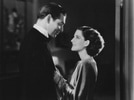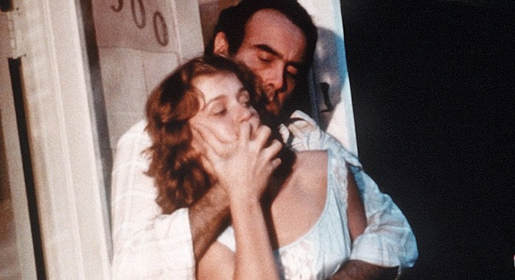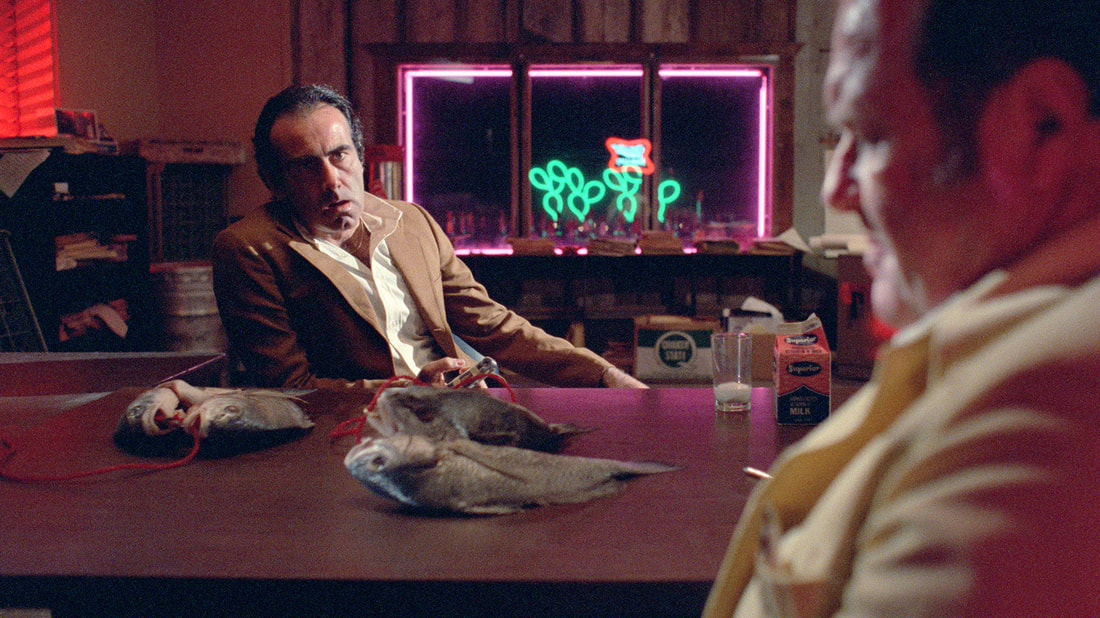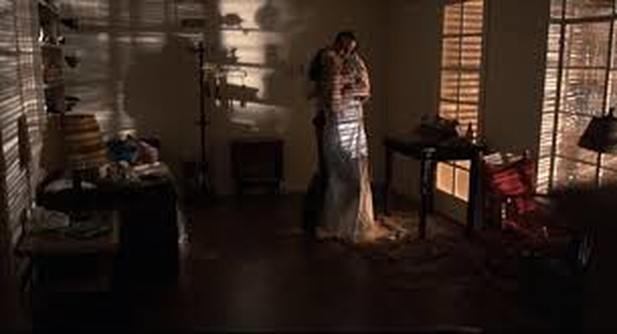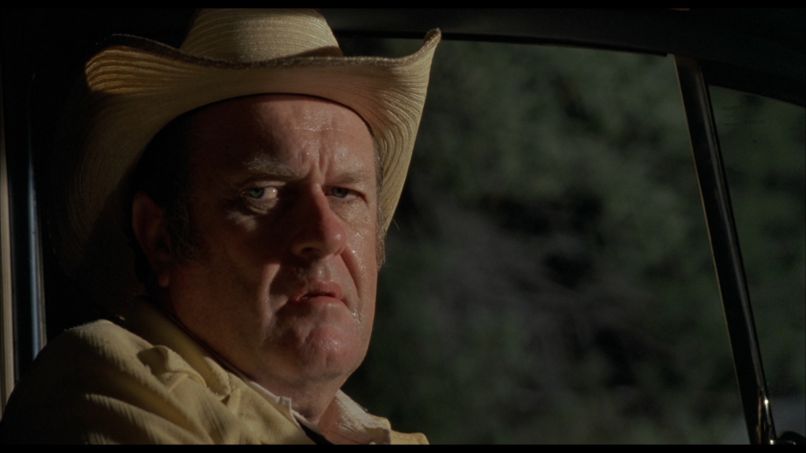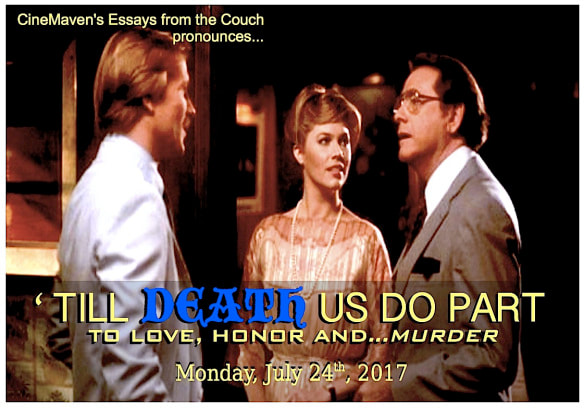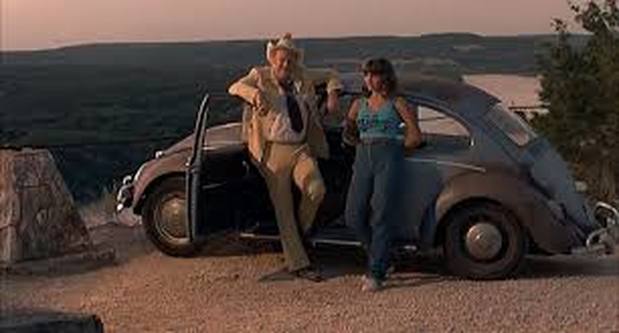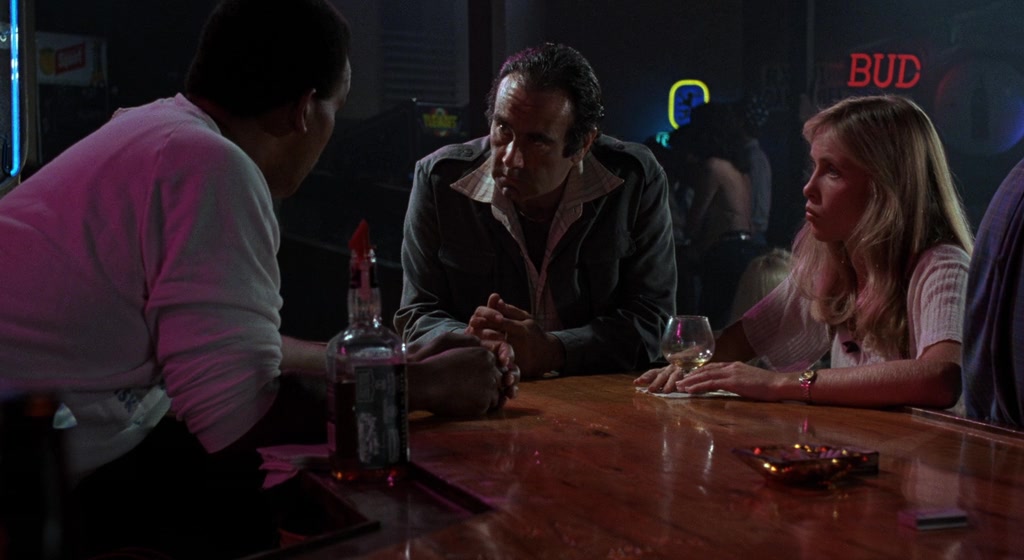|
Nutshell Review: Blood Simple (1984)
Director: Joel & Ethan Coen Starring: John Getz, Frances McDormand, Dan Hedeya, M. Emmet Walsh Studio: USA Films (Universal My IBDB Rating: 7 Viewing: Universal Studios Blu-Ray Till Death Do Us Part Blogathon Link: https://cinemavensessaysfromthecouch.wordpress.com/2017/07/24/till-death-us-do-part-2/ |
Plot:
Abby (McDormand) is married to Julian Marty (Hedaya), a honkytonk owner somewhere in Texas. Not trusting her, Marty puts private detective Loren Visser (Walsh) on her tail as she flees town with one of Marty’s bartenders, Ray (Getz). After she impulsively sleeps with Ray, providing Visser with visual evidence of her indiscretion, she returns home to retrieve a few things, including the gun Marty gave her. Presented with the evidence of her infidelity, Marty asks Visser to kill both Abby & Ray. Visser, however, double crosses Marty and shoots him, taking the $10,000, but leaving behind evidence of his double cross in the form of a doctored picture.
In an attempt to get back pay from Marty, Ray goes to the bar, stumbles onto the murder scene and assuming Abby killed him, tries to bury Marty and cover up the crime. The following morning he assures Abby that everything is taken care of, but denies any knowledge of the killing. Visser, meanwhile, become s aware that evidence of his crime may have slipped into Abby’s hands so he attempts to kill her, but instead kills Ray. Abby escapes and shoots Visser, killing him.
Abby (McDormand) is married to Julian Marty (Hedaya), a honkytonk owner somewhere in Texas. Not trusting her, Marty puts private detective Loren Visser (Walsh) on her tail as she flees town with one of Marty’s bartenders, Ray (Getz). After she impulsively sleeps with Ray, providing Visser with visual evidence of her indiscretion, she returns home to retrieve a few things, including the gun Marty gave her. Presented with the evidence of her infidelity, Marty asks Visser to kill both Abby & Ray. Visser, however, double crosses Marty and shoots him, taking the $10,000, but leaving behind evidence of his double cross in the form of a doctored picture.
In an attempt to get back pay from Marty, Ray goes to the bar, stumbles onto the murder scene and assuming Abby killed him, tries to bury Marty and cover up the crime. The following morning he assures Abby that everything is taken care of, but denies any knowledge of the killing. Visser, meanwhile, become s aware that evidence of his crime may have slipped into Abby’s hands so he attempts to kill her, but instead kills Ray. Abby escapes and shoots Visser, killing him.
Thoughts:
The Coen Brothers debut, along with a great deal of their filmography is called postmodern, a pastiche of genre conventions turned inside out and upside down. Blood Simple is at its core Film Noir in the same vein as The Postman Rings Twice, Double Indemnity & Body Heat, steeped in the writings of James M. Cain & Dashell Hammett & the filmmaking of Billy Wilder & Fritz Lang (Woman in the Window, Scarlett Street). While certain genre conventions are adhered to with twisted reverence, the Coen’s primary concern seems to be to build a crime story, that spirals in on itself to reveal that life, when touched with evil, is nothing more than a series of random events and misunderstandings.
For me, what sets Blood Simple apart from classic Noir are the twists they place on the basic love triangle. In the classic films the femme fatale is the catalyst of the plot, driving her partner to action through lust, passion & sex. Here, however, Abby is a passive participant letting first Marty, then Ray, & finally Visser drive her actions & reactions. Her leaving town sets the plot in motion, but it is Marty, the husband, who brings in Visser to start the killing. Perhaps if Nick (Postman) or Mr. Dietrich (Double Indemnity) where aware of the duplicitous fatale under their roofs, like Marty suspects of Abby, maybe they could have avoided their fate. Marty, however, brings a fourth actor into the love triangle and pays dearly for it. The Coen’s inclusion of a 4th participant throws the mechanics of the story off kilter, providing multiple antagonists, while at the same time removing the adulterous couple from propelling the story forward.
Visser’s double cross of Marty, another common Noir plot element, is yet another genre convention turned on its ear. Instead of carrying through with the double murder plot that Marty has initiated, Visser’s doctored pictures and attempted framing of Abby turn the plot back towards the traditional outcome of the love triangle. Ray’s attempt to clean up the ‘murder’ scene (10 minutes of wordless tension) is reminiscent of classic Noir films, but in the Coen’s hands it’s all jumbled. Abby is the innocent; Ray is the love sick sap, and Marty is the victim. There is no actor within the triangle. Visser, on the other hand, must pay for his double cross, but not at the hand of his victim or even the law. In Coen-land, the innocent executes retribution for the double cross.
As noted, both Ray & Abby are generally passive participants in the murder plots around them, but when Ray stumbles onto the murder scene the Coen’s move him to would be active player. Unfortunately, Marty is not dead as Ray assumed and his actions are misguided, towards protecting Visser, instead of Abby. The repeated foreshadowing of the importance of Visser’s lighter, borrows from Hitchcock’s McGuffin plot devices adds an additional classic element to the proceedings, while the blood soaked back seat in Ray’s car reflects the futility of his efforts.
Abby & Ray, in Ray’s mind at least, are bound by not only their love, but by the murder of Abby’s husband. Since they both suspect each other of the killing, however, the normal Noir convention of doubt and mistrust is fully sewn. Only Visser, as the avenging angel, saves their relationship from destruction, when he first kills Ray, then goes after Abby. Just as the Frank & Cora from Postman Always Rings Twice only recognizes that their love was pure when it’s too late, Abby sees that Ray is not to blame for Marty’s death. Her determination to kill Visser, born out of desperation and necessity adds the final Noir wrinkle to Blood Simple. Instead of the hero, or the police, coming to save the heroine, here it is Abby who must save herself. In a battle more typical of a classic Western gun battle, her repeated outsmarting of Visser is a cleverly crafted tango, Gone is the passive participant, replaced by a shred an smart survivor.
The randomness of the plot turns in Blood Simple is what make it special. Long assumed genre conventions are throw out or randomly altered, bent by a world driven chance. Visser choosing a double cross over murder, Ray showing up at the bar, Marty throwing the fish onto the lighter & Abby grabbing the pearl handled anniversary gift are all minor moments that snowball into life altering events for the characters. As the song goes, “It’s the same old song, just a different story since you’ve been gone…”
Category: Film Noir, Neo-Noir
See Also: The Man Who Wasn’t There, Barton Fink, Red Rock West, Last Seduction
Random Notes & Quotes:
*Blood Simple was made for $1.5M dollars. To save money the Coen’s developed detailed storyboards for every shot in an effort to be as efficient on set as possible. While the Texas location is perfect for the plot it was also chosen because it’s a right to work state and they didn’t have to pay union wages.
*David Ansen, writing in Newsweek, called Blood Simple “The most innovative and original thriller in many-a-moon. A maliciously entertaining murder story.”
*The body writhing around in the grave a Ray covers Marty is actually one of the Coen brothers captured later for shot pick up reasons.
*Holly Hunter was originally supposed to play Abby, but couldn’t commit, so she suggested her friend Frances McDormand, who ended up marrying Joel Coen.
*The voice on Meurice’s answering machine is an uncredited Holly Hunter.
*The term “blood simple” is borrowed from Hammett to explain the effect murder has on the perpetrators brain.
The Coen Brothers debut, along with a great deal of their filmography is called postmodern, a pastiche of genre conventions turned inside out and upside down. Blood Simple is at its core Film Noir in the same vein as The Postman Rings Twice, Double Indemnity & Body Heat, steeped in the writings of James M. Cain & Dashell Hammett & the filmmaking of Billy Wilder & Fritz Lang (Woman in the Window, Scarlett Street). While certain genre conventions are adhered to with twisted reverence, the Coen’s primary concern seems to be to build a crime story, that spirals in on itself to reveal that life, when touched with evil, is nothing more than a series of random events and misunderstandings.
For me, what sets Blood Simple apart from classic Noir are the twists they place on the basic love triangle. In the classic films the femme fatale is the catalyst of the plot, driving her partner to action through lust, passion & sex. Here, however, Abby is a passive participant letting first Marty, then Ray, & finally Visser drive her actions & reactions. Her leaving town sets the plot in motion, but it is Marty, the husband, who brings in Visser to start the killing. Perhaps if Nick (Postman) or Mr. Dietrich (Double Indemnity) where aware of the duplicitous fatale under their roofs, like Marty suspects of Abby, maybe they could have avoided their fate. Marty, however, brings a fourth actor into the love triangle and pays dearly for it. The Coen’s inclusion of a 4th participant throws the mechanics of the story off kilter, providing multiple antagonists, while at the same time removing the adulterous couple from propelling the story forward.
Visser’s double cross of Marty, another common Noir plot element, is yet another genre convention turned on its ear. Instead of carrying through with the double murder plot that Marty has initiated, Visser’s doctored pictures and attempted framing of Abby turn the plot back towards the traditional outcome of the love triangle. Ray’s attempt to clean up the ‘murder’ scene (10 minutes of wordless tension) is reminiscent of classic Noir films, but in the Coen’s hands it’s all jumbled. Abby is the innocent; Ray is the love sick sap, and Marty is the victim. There is no actor within the triangle. Visser, on the other hand, must pay for his double cross, but not at the hand of his victim or even the law. In Coen-land, the innocent executes retribution for the double cross.
As noted, both Ray & Abby are generally passive participants in the murder plots around them, but when Ray stumbles onto the murder scene the Coen’s move him to would be active player. Unfortunately, Marty is not dead as Ray assumed and his actions are misguided, towards protecting Visser, instead of Abby. The repeated foreshadowing of the importance of Visser’s lighter, borrows from Hitchcock’s McGuffin plot devices adds an additional classic element to the proceedings, while the blood soaked back seat in Ray’s car reflects the futility of his efforts.
Abby & Ray, in Ray’s mind at least, are bound by not only their love, but by the murder of Abby’s husband. Since they both suspect each other of the killing, however, the normal Noir convention of doubt and mistrust is fully sewn. Only Visser, as the avenging angel, saves their relationship from destruction, when he first kills Ray, then goes after Abby. Just as the Frank & Cora from Postman Always Rings Twice only recognizes that their love was pure when it’s too late, Abby sees that Ray is not to blame for Marty’s death. Her determination to kill Visser, born out of desperation and necessity adds the final Noir wrinkle to Blood Simple. Instead of the hero, or the police, coming to save the heroine, here it is Abby who must save herself. In a battle more typical of a classic Western gun battle, her repeated outsmarting of Visser is a cleverly crafted tango, Gone is the passive participant, replaced by a shred an smart survivor.
The randomness of the plot turns in Blood Simple is what make it special. Long assumed genre conventions are throw out or randomly altered, bent by a world driven chance. Visser choosing a double cross over murder, Ray showing up at the bar, Marty throwing the fish onto the lighter & Abby grabbing the pearl handled anniversary gift are all minor moments that snowball into life altering events for the characters. As the song goes, “It’s the same old song, just a different story since you’ve been gone…”
Category: Film Noir, Neo-Noir
See Also: The Man Who Wasn’t There, Barton Fink, Red Rock West, Last Seduction
Random Notes & Quotes:
*Blood Simple was made for $1.5M dollars. To save money the Coen’s developed detailed storyboards for every shot in an effort to be as efficient on set as possible. While the Texas location is perfect for the plot it was also chosen because it’s a right to work state and they didn’t have to pay union wages.
*David Ansen, writing in Newsweek, called Blood Simple “The most innovative and original thriller in many-a-moon. A maliciously entertaining murder story.”
*The body writhing around in the grave a Ray covers Marty is actually one of the Coen brothers captured later for shot pick up reasons.
*Holly Hunter was originally supposed to play Abby, but couldn’t commit, so she suggested her friend Frances McDormand, who ended up marrying Joel Coen.
*The voice on Meurice’s answering machine is an uncredited Holly Hunter.
*The term “blood simple” is borrowed from Hammett to explain the effect murder has on the perpetrators brain.
